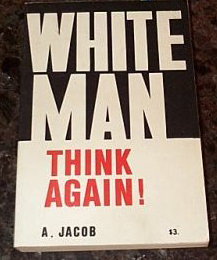ME: ... It should be obvious that Master Race does not suggest Herrenvolk and that Herrenvolk does not suggest Master Race. Hitler uses the term Herrenvolk in the sense of dominant race of people in Mein Kampf, but he does not identify this dominant race of people with the Germans, only the Aryans. And so on. To most people, this will seem like hair-splitting. But it makes a difference.
For example. The Jews are the dominant racial or ethnic group in America, and most other Western countries. No one would deny this. They often admit it, and brag about it. But they would never admit to being a Master Race, and I would never call them a Master Race. What the hell is this supposed to mean, I'm supposed to bow down and worship them, they have a right to lead me around on a dog collar, like Lynndie England at Abu Ghraib? Hell, no!

But I think even the Jews would admit to being a Herrenvolk, they would feel flattered, because Herrenvolk implies a race or people enjoying a dominant position because of some innate quality, a people in a position of superior power who deserve respect. This is the way people in positions of national dominance ALWAYS regard themselves, just look at the colonial powers. There are no exceptions.
It is obvious that the alleged "translation" of this one very unsual coined word, Herrenvolk, "Master Race", was deliberately calculated to elicit this reaction of repugnance and disgust. It's like advertising: you've got a soap powder that's a miserable product, but you invent some fantastically catchy slogan, like "Rinso-Sudso suds your duds, Rinso-Sudso-sudsy-wuds, Rinso-Sudso!!!" (music), and you make millions, even if the product is garbage. That's what they did with this one lousy word, used a known total of 6 times [!].
To me, "Master Race" is too narrow to be a correct general translation for "Herrenvolk", even if you could prove it was an acceptable translation in certain contexts. It's like seeing the word "bird" and translating it as a certain kind of bird -- cedar waxwing, Baltimore oriole, or azure-winged magpie, etc..
Herrenvolk implies a people who deserve respect. It does not imply a slave master dragging people around on a dog leash. When you translate you respect the intention, the thought. You think, what is this person trying to say, how would he say it if he was a native English speaker in an original piece of English? No colonial power would call itself a Master Race. They simply say, look, we're in charge around here, we represent a superior civilization, democracy and development, and so on, so you people have to do what we say. If you're translating Stephen Foster songs about slavery and the song says kindly ole Massa, you don't translate it as evil, greedy, predatory ole Massah what be exploitin' the horny handed sons of toil, us niggahs, see.
That's what they've done. The term Master Race is a trick, a con, added to make ordinary concepts and ideas seem horrifying. There is nothing original about speculating that once upon a time, whites were the dominant racial group (the Herrenvolk) in America, Britain, South Africa, or Australia, but they lost their self-confidence, their belief in themselves, their will to retain themselves in power (their Herrenstandpunkt), so they lost their power. Now the niggers and the chinks and so on are the dominant racial group, the Herrenvolk. It's just a trick of semantics. When R. Crumb shows a nigger telling the President of the United States, "yo' fo'foddahs wuz bad-asses (a Herrenvolk), but you be weak (Ihr seid ein Knechtvolk), it's the same idea. These are normal ideas. We hear these everyday. There is no need for these grotesque pseudo-Germanic, pseudo-Teutonic compounds, Master Race. It's rubbish. Almost all these passages in Mein Kampf are purely speculative, they relate to the far distant past and future. For example, did you know did you know that the Australian aborigines originally came from the Indian subcontinent? They are Dravidians, a low-caste Indian racial group. The Tasmanians are Papuans, a primitive black race from the South Seas. The Tasmanians never set foot in Australia. Neither one can sail worth a damn. So how the hell did they get there?
All over the South Seas, for example, the Caroline Islands, you find fantastic stone remnants of ancient civilizations, enormous stone causeways, monuments, canals miles long cut through solid rock. Nobody believes the ancestors of the present-day island natives built these things. So there is a great deal of circumstantial evidence of what Hitler says in vol. 1, chapter 10, of Mein Kampf. That at one time in the distant past, an ancient Aryan race conquered most of the world and that remnants of these peoples can still be seen. Anywhere you look in the world, wherever there are different racial groups or mixing, the lightest-skinned racial group in always in a position of dominance (they are a Herrenvolk). You can see this in South America, Asia, Europe, Africa, all over.
There is considerable evidence for this; academically, it is known as "Solutreanism", click here or here or here.
There are several documentary films on the subject, perhaps most notably ICE AGE COLUMBUS.
In other words, the contexts in which Hitler uses the word "Herrenvolk" (a grand total of 3 times) are neither particularly original nor particularly controversial.
Obviously, it's not just lightness of skin that makes Aryans superior, rather, the whiteness of skin is an exterior indication of complex genetic differences which predominate throughout the body. Every cell in the body is different between different races. Any police scientist can verify this. You think the cops can't tell the difference between the races from a skull? Everything Hitler says in this connection can be verified. For example, my own info on the aborigines and the Tasmanians and the Caroline Islands comes from the 1911 Encyclopaedia Britannica. The best other book I know of on these problems is called WHITE MAN, THINK AGAIN, by a South African named Anthony Jacob (who appears to have been an anti-Communist Jew), usually available from amazon.com or abebooks.com,

One of the best works on the incapacity of the Africans and the self-destruction of white civilization in Africa
or THE MARCH OF THE TITANS, by Arthur Kemp. In Mexico, the ruling classes, the Herrenvolk, are all white. In Haiti, they are mulatto. And so on. They are the remains of an ancient Herrenvolk, a dominant race. But this does not imply that Hitler believed that the Germans in particular had the right to drag the Poles, French, Dutch, etc., around on a dog leash.
What's more, everything he ever did contradicts almost everything he says in Mein Kampf. His actual career in politics was not what one would have expected from reading Mein Kampf. To explain what he says in Mein Kamp would require a discussion of the historical context in which Mein Kampf was written, in 1924 – 1927, for God's sake, which was very early...
The real translation of Herrenvolk (an almost unknown coined word, almost never used, 3 times by Hitler and 6 times total), is, to me, a people which respects itself and expects to be respected by others. A people in which the working class and bourgeoisie, manual workers and intellectual workers, are placed on a basis of equality and treat each other with respect. A people which is master in its own house. A people which is its own master, and is master of the situation. An independent people. Herrschen means to rule and one of the translations for Herrscher, ruler, is sovereign, i.e., independent. Herrenvolk does not mean a race, and Herrenvolk does not Sklavenherrenrasse, Herrscherrasse, or anything else of the kind. These words have no negative connotations. It is almost impossible to put them together in such a was as to get a negative meaning. If you described the Spanish as "un pueblo de hombres, pueblo de señores, pueblo de caballeros", etc., it would be taken as an enormous compliment. This is true in all languages. If they didn't understand "pueblo de señores" at first, then you could simply say that in Spain, ordinary people possess a quality known as "señorío", which means dignity, stateliness, etc., in addition to all the other qualities inherent in being a man, i.e., courage, dignity, pride, self-respect, reliability, a sense of honour, a sense of chivalry, etc. The same is true in Italian, Portuguese, and French, mutatis mutandis. Herr is a term of respect. A Herrenvolk is what they would call in Italian "un popolo che si fa rispettare". A man who "causes himself to be respected" had damn well better be treated with respect...
...On race, see RACE, EVOLUTION AND BEHAVIOR by J. Philippe Rushton (the full-length book, not simply the midget version), or RACE by John R. Baker of Oxford University...
As I was saying, about the Caroline Islands.....